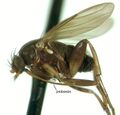Dohrniphora
There are three species in this parasitoid genus of Phoridae that attack ants.
All species of flies had similar behavior, documented in video clips. Flies arrived shortly after the ants were injured, usually arriving as in copula pairs in flight, cruising back and forth above the ants. After the pair landed, males immediately departed and females approached the injured Odontomachus. Females of the Dohrniphora longirostrata species group are distinctive because of their greatly elongated proboscis, which is almost as long as their entire body. In our observations, this proboscis is used to separate the ant’s head from the rest of the body. Study of the structure of the apex of the proboscis shows that the epipharynx is extremely modified as a bladed cutting organ that is used in the process of severing the ant's head.
| Genus and species | Author and Year | Ant Host | Distribution | |
|---|---|---|---|---|
| Dohrniphora conlanorum | Kung & Brown, 2005 | Odontomachus | Costa Rica | |
| Dohrniphora longirostrata | (Enderlein, 1912) | Odontomachus | Brazil | |
| Dohrniphora oricilla | Kung & Brown, 2005 | Odontomachus | Costa Rica |
REFERENCES
- Brown BV. Differential host use by neotropical phorid flies (Diptera: Phoridae) that are parasitoids of ants (Hymenoptera: Formicidae) Sociobiology. 1999;33(3):95–103.
- Brown BV, Kung GA, Porras W. A new type of ant-decapitation in the Phoridae (Insecta: Diptera). Biodivers Data J. 2015 Jan 2;(3):e4299
- Enderlein, G. 1912. Die Phoridenfauna Süd-Brasiliens. Stettiner Entomologische Zeitung 73: 16-45. [1912.03.20]
- Kung, G.-A. & Brown, B.V. 2005. New species of Dohrniphora related to D. longirostrata (Diptera: Phoridae). Annals of the Entomological Society of America 98: 55-62.
